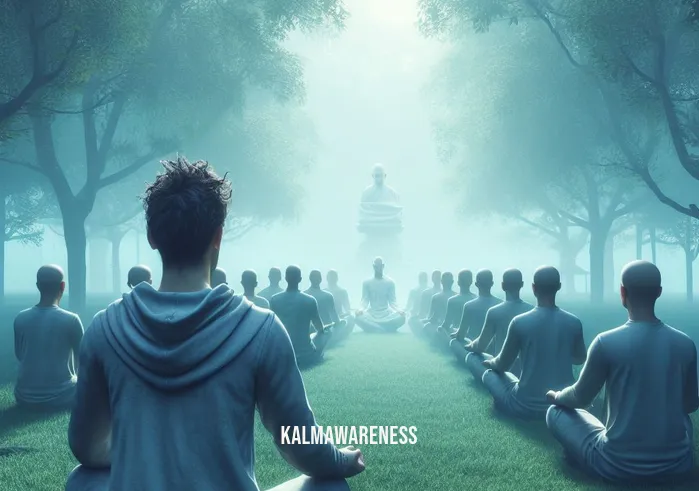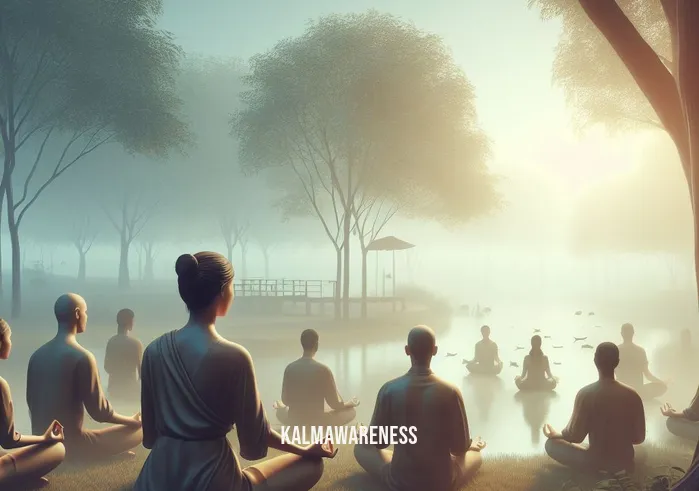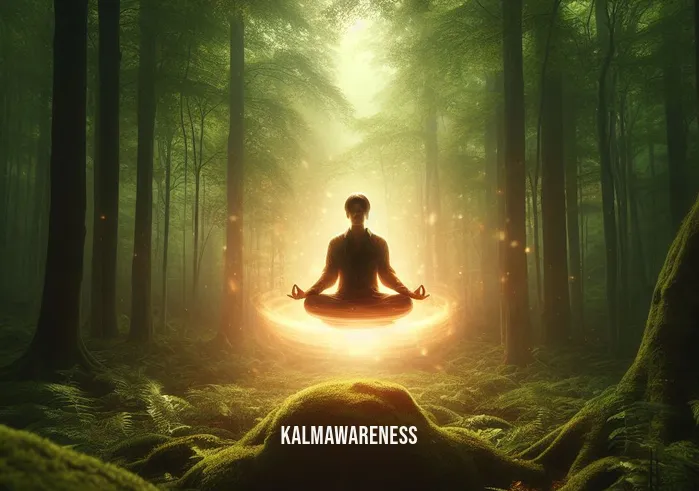Why People Think “Meditation is Boring” and What to Do About It
For many, the mere mention of the word “meditation” might evoke images of silent rooms, stillness, and seemingly endless periods of inactivity. A common refrain heard is that meditation is boring. But what if this perception is the result of misunderstandings or a lack of exposure to the various dynamic and engaging forms of meditation? In this series, we will explore the rich tapestry of meditation techniques, aiming to debunk the myth that it’s a monotonous activity and enlightening readers on its multifaceted nature.
Meditation: Beyond the Stereotypes
To start, it’s crucial to keep in mind the definition of meditation. At its core, meditation involves attaining a peaceful state of mind in which thoughts are not occupied by worry. But how one achieves this state can vary greatly. From movement-based practices to vocalizations, there’s likely a meditation style that caters to everyone’s preference.
Understanding the Different Styles
Guided Meditation: For those who find it challenging to meditate independently, Jack Kornfield’s Meditation for Beginners serves as an excellent starting point. Guided meditation, as the name suggests, involves following a guide—usually a voice recording or a teacher—that walks the practitioner through a meditative experience. This can include mindful movement for sleep, helping the mind and body relax through movement.
Mindfulness: Rooted in Buddhist tradition, mindfulness encourages practitioners to remain present. It emphasizes observing thoughts and feelings without judgment, an essential trait emphasized in the judgement of the wise.
Visualization: This involves mentally imagining serene and peaceful scenes, like a quiet forest or a tranquil beach. Some find immense peace in exercises such as mirror gazing for its spiritual benefits.
Mantra: Often associated with traditions like Hinduism and Buddhism, mantra meditation involves the repetition of a word or phrase. It’s believed to elevate the meditator to higher states of consciousness. This repetition is an element of some meditation exercises and can help stabilize the mind, especially for those pondering how to spell ‘stabilize’.
Breathwork: A core component of many meditation practices, breathwork is about focusing on one’s breath. It’s not just about the act of breathing but how we perceive it. Practices such as Rouse Yoga incorporate breathwork to aid in attaining a meditative state.
Meditation is as diverse as its practitioners, and the richness of its styles is a testament to its adaptability and universality.
Why the “Boring” Label?
One reason many consider meditation boring might be due to a lack of exposure to its varied forms. Another could be a misalignment between an individual’s chosen method and what resonates with them. For instance, someone might find a silent, seated meditation tedious but might thoroughly enjoy mindful hypnobirthing or feel a deep connection while meditating lying down.
Moreover, the way meditation is sometimes portrayed—in stillness and silence—may not appeal to everyone, especially in an age of how we get deep so fast. The key is to remember that it’s a personal journey. Just as there are various forms of exercise, there are multiple meditation techniques. It’s all about finding the one that aligns with your needs and resonates with your spirit.
Setting the Stage for a Deeper Dive
In the subsequent segments, we’ll delve deeper into each meditation style, explore their origins, benefits, and techniques. We’ll also provide insights on how to integrate these practices into daily life, ensuring sustainable self-care for both mind and body.
Our journey will also explore the incorporation of gratitude practices like [gratitude meditation for

Unpacking the “Meditation is Boring” Myth
The idea that meditation is monotonous has been deeply ingrained in popular culture, largely due to stereotypical portrayals and misunderstandings. But as we dive deeper, it becomes evident that the vast array of meditation techniques offer dynamic experiences that can captivate and transform the practitioner. Let’s debunk the misconceptions surrounding “meditation is boring” and shine a light on its vibrant, varied facets.
Common Misconceptions and Their Origins
Stillness Equals Monotony: The belief that meditation solely involves sitting still can lead to the assumption of it being tedious. However, practices like teenagers walking meditation showcase the dynamic nature of many techniques.
Lack of Immediate Results: In our fast-paced world, where results are often expected instantly, meditation’s subtler, long-term benefits might be overlooked, leading some to label it as uneventful or pretty soon meaning it becomes insignificant.
Limited Exposure: Being exposed to just one style or form of meditation can lead to a skewed perspective. Exploring diverse techniques can reveal how engaging and varied meditation can truly be.
Benefits Often Overlooked
Many forget or are unaware of the profound benefits meditation offers, making it easy to dismiss as dull. Here are some less-discussed benefits that challenge the “boring” label:
Enhanced Self-awareness: Techniques like touching that body part meditation increase bodily awareness, fostering a deep connection between mind and body.
Increased Tolerance to Discomfort: Over time, meditation can increase one’s threshold for discomfort, both physical and emotional.
Creativity Boost: By calming the mind, meditation can pave the way for creative thoughts to flow freely.
Improved Sleep Quality: Practices centered around gratitude meditation for sleep have shown significant improvements in sleep quality.
Types of Meditation vs. Experiences They Offer
| Type of Meditation | Primary Focus | Experiences Often Overlooked |
|---|---|---|
| Mindfulness | Present Moment | Deep connection with surroundings, acute sensory experiences. |
| Mantra | Repetition | Transcendental experiences, moments of profound clarity. |
| Visualization | Mental Imagery | Journey-like experiences, often vivid and emotionally rich. |
| Breathwork | Breathing | Euphoria, heightened self-awareness. |
| Guided | Following a Guide | Diverse experiences based on the guide’s narrative, from relaxation to insightful journeys. |
Expanding Horizons: Exploring Beyond the Surface
It’s worth noting that meditation, like many other practices, requires consistent effort and exploration. Labeling it as “boring” after a brief or singular experience can be likened to judging a book by its cover or judging the wisdom of practices based on surface knowledge.
For those eager to dive deeper, resources like Meditation Made Simple offer a plethora of techniques, shedding light on meditation’s richness. Another compelling tool is maintaining a daily journal, perhaps one for each blessed day, to track progress, insights, and breakthroughs, making the process more tangible and engaging.
Anticipating What Lies Ahead
As we move forward, it’s vital to approach meditation with an open heart and mind, giving it the time and patience it deserves. In the next chapter, we will delve into personal anecdotes and transformational stories that further dismantle the “meditation is boring” myth, showcasing the profound impact it has had on countless lives. So, stay curious, and continue reading to unveil the mesmerizing world of meditation.

Discovering Hope Amidst the “Meditation is Boring” Narrative
Meditation, often mistakenly branded as mundane, carries within it seeds of transformation. As individuals across the globe have discovered, when approached with an open heart, it becomes a source of hope, inspiration, and profound change. Through heartfelt testimonials, impactful quotes, and compelling stories, this chapter aims to reveal the shimmering depths beneath the “meditation is boring” surface.
Stories of Hope and Transformation
Sarah’s Journey: Sarah, a young entrepreneur, initially felt meditation was dull. But when she chanced upon how to train your mind to be stronger than your feelings, she realized meditation was her tool to regain emotional balance. Today, she credits her mental resilience to her dedicated meditation practice.
Mark’s Rebirth: Battling addiction, Mark felt lost. A friend introduced him to sustainable self-care techniques, central to which was meditation. Mark shares, “Every meditation session became a step away from my past and towards a brighter future.”
Quotes to Ignite the Spirit
“In the silence of meditation, I discovered the voice of my soul.” – Anonymous
“Do not judge meditation by the stillness outside but by the transformation inside.” – Lao Tzu
“To say meditation is boring is to say life itself is mundane. Both unravel layers with patience.” – Rumi
“Meditation isn’t about escaping reality but diving deeper into it.” – Thich Nhat Hanh
“In meditation, every breath dispels a myth, every moment births a revelation.” – Maya Angelou
Challenging the Monotony Myth
If we were to analyze the element of some meditation exercises, it becomes evident that monotony is not an inherent part of meditation, but rather a perception borne out of unfamiliarity or impatience.
Consider Jessica, a college student overwhelmed with stress. She once remarked, “Meditation? It feels too passive.” Yet, when introduced to Jack Kornfield’s meditation techniques for beginners, her perspective shifted. She discovered that meditation wasn’t about inaction but about profound internal exploration.
Or take Alex, who believed meditation wasn’t suited for “active” individuals like him. His views transformed after attending a mindful movement sleep session. He learned that meditation could be dynamic and even physically engaging.
Beyond Boredom: The Layers Awaiting Exploration
The “meditation is boring” narrative is but the tip of an iceberg. Beneath it lies a world rich with experiences, insights, and transformative potential. It’s a realm where every thought has depth, every emotion has meaning, and every moment is an opportunity for growth. By embracing practices like mirror gazing for its spiritual benefits or delving into the principles highlighted in judgement of the wise, one can unearth meditation’s multifaceted beauty.
Gearing Up for the Journey Ahead
As we forge ahead, we’ll delve into the practicalities of meditation. How can one integrate it seamlessly into daily life? How do we navigate the initial challenges? In the next chapter, expect a treasure trove of actionable tips, techniques, and guidance that will help transform the seemingly mundane meditation sessions into journeys of discovery. Continue reading to equip yourself for this exciting adventure into the self.

Decoding the “Meditation is Boring” Perception
As we delve deeper into the world of meditation, it’s crucial to dissect the overarching sentiment that “meditation is boring.” By breaking down this perception into its components, we can address each element, offering insights, clarifications, and actionable steps. This chapter will use lists and bullet points to deconstruct and illuminate the myriad aspects of this prevalent myth.
Why Meditation Might Feel Boring: Root Causes
Misaligned Expectations: Comparing meditation to adrenaline-pumping activities might lead to feelings of underwhelm.
Lack of Understanding: Without grasping the profound implications of meditation, it’s easy to label it as uneventful.
Impatience: Living in an era of instant gratification, the subtle, gradual results of meditation might seem lackluster.
Unsuitable Techniques: Not every meditation style suits everyone. Using a mismatched technique can lead to feelings of boredom or disinterest.
Breaking Down the Benefits of Meditation
Physical Well-being:
- Improved sleep patterns.
- Lowered blood pressure.
- Enhanced immunity.
Emotional Balance:
- Greater resilience to stress.
- Enhanced emotional intelligence.
- Reduced feelings of anxiety and depression.
Cognitive Advancements:
- Improved focus and concentration.
- Enhanced memory retention.
- Boosted creativity.
Spiritual Growth:
- Deepened self-awareness.
- Connection with the universe or higher self.
- Enhanced compassion and empathy.
Effective Ways to Make Meditation Engaging
Incorporate Variety: Just as one can meditate lying down, there are myriad ways to practice. Experiment to find what resonates.
Set Clear Intentions: Establishing a purpose, whether it’s seeking relaxation, clarity, or connection, can enhance engagement.
Join a Group: Sharing the experience with others, perhaps in a setting like Rouse Yoga, can make it more enjoyable.
Document the Journey: Keeping a journal or following a routine one for each blessed day can add a tangible element to the process.
Demystifying Common Meditation Myths
Myth: Meditation requires hours of commitment.
- Truth: Even a few minutes daily can yield significant benefits.
Myth: You need to be religious or spiritual.
- Truth: Meditation transcends religious boundaries and can be practiced by anyone.
Myth: It’s about suppressing thoughts.
- Truth: Meditation is about observing thoughts without judgment.
Steps to Counteract the Boredom
Educate Yourself: Dive into resources like Meditation Made Simple to deepen understanding and appreciation.
Challenge Yourself: Set milestones or goals. For example, meditate for 21 days straight or explore a new technique each week.
Celebrate Small Wins: Every time you overcome restlessness or achieve deeper focus, take a moment to acknowledge your progress.
Seek Feedback: Share experiences with peers or mentors, gaining insights to refine your practice.
Anticipating the Grand Finale
Our exploration has led us through various facets of meditation, from its misconceptions to its undeniable benefits. As we approach the culmination of this journey, the next chapter will synthesize our learnings, offering a holistic perspective on meditation. With insights, actionable strategies, and a fresh lens to view meditation, we invite you to the final chapter, promising a revelatory conclusion.

Reflections on “Meditation is Boring”: A Journey of Discovery
As we draw the curtains on our exploration of the widespread sentiment that “meditation is boring,” it’s time to pause, reflect, and appreciate the rich tapestry of insights, stories, and revelations we’ve encountered. Like any profound journey, ours was filled with moments of discovery, introspection, and transformation.
Journey Highlights: A Quick Recap
Debunking Myths: We delved into common misconceptions about meditation, highlighting its dynamic nature and the myriad forms it can take, from mindful hypnobirthing to active sessions like teenagers walking.
Voices of Transformation: Through stories and testimonials, we learned how individuals across the globe have found hope, solace, and inspiration in meditation, moving past initial judgments.
Practical Insights: With actionable steps, we discovered ways to make meditation engaging, challenging the stereotype of it being mundane or monotonous.
Applying Our Learnings
Understanding that meditation is far from dull is just the beginning. Here’s how to apply this knowledge:
Experiment: Given the diversity of meditation techniques, there’s likely something for everyone. Be it touching that body part meditation or a gratitude meditation for sleep, the key is to explore.
Consistency Over Intensity: It’s more beneficial to meditate for a few minutes daily than sporadically for hours. Consistency can be the antidote to feelings of monotony.
Seek Community: Engaging with like-minded individuals or groups can make the journey more fulfilling.
Your Next Steps
Our exploration may have reached its conclusion, but your personal journey with meditation is just beginning. Here’s a call-to-action for all our curious souls:
Explore More: Dive deeper into the wealth of resources available on our platform. Whether you’re seeking techniques, stories, or expert interviews, we’ve got a trove of content waiting for you.
Revisit and Reflect: If ever in doubt or seeking clarity, revisit previous sections of this series. Each reading might offer a fresh perspective or deeper insight.
Share and Grow: Discuss your experiences and learnings with friends or in our community forums. Sharing not only reinforces knowledge but can also inspire others.
A Heartfelt Thank You
We’re deeply grateful to our readers for embarking on this enlightening journey with us. Your curiosity, engagement, and feedback have made this exploration rewarding. Rest assured, we remain committed to bringing you more insightful, transformative content in future editions.
As we wrap up, always remember: Meditation, often perceived as mundane, is a vast ocean. On its surface, it might seem still, but dive deeper, and you’ll discover a vibrant world teeming with life, energy, and endless possibilities. Until our next adventure, happy meditating!




